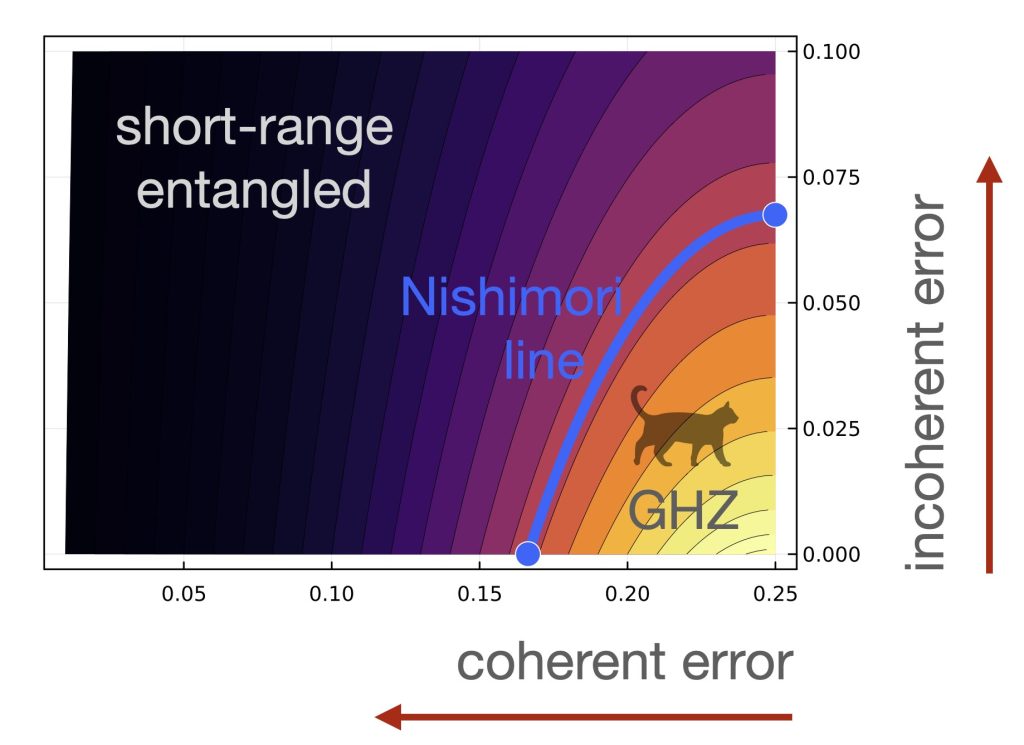Today on arXiv: Joint work by the Trebst group together with IBM Quantum on Nishimori transition
Update: The preprint was published on November 15 in Phys. Rev. Lett.
Nishimori’s Cat: Stable Long-Range Entanglement from Finite-Depth Unitaries and Weak Measurements. Guo-Yi Zhu, Nathanan Tantivasadakarn, Ashvin Vishwanath, Simon Trebst, and Ruben Verresen. Phys. Rev. Lett. 131, 200201
In collaboration with IBM Quantum, recent work by Guo-Yi Zhu and Simon Trebst appeared today on the preprint server arXiv. The paper entitled Realizing the Nishimori transition across the error threshold for constant-depth quantum circuits shows results from tuning an actual 127 qubit device through Nishimori transition on the IBM quantum platform. The collaboration also included scientists from the Department of Physics at Harvard University as well as the Walter Burke Institute for Theoretical Physics and the Department of Physics at the California Institute of Technology. In the preprint, the authors connect to seminal work by Dennis, Kitaev, Landahl, & Preskill on error thresholds & decoding — while these established resilience against incoherent noise, the work published today discusses stability against coherent errors. Both limits are connected via a line of Nishimori transitions (see figure).
Publication:
Realizing the Nishimori transition across the error threshold for constant-depth quantum circuits, Edward H. Chen, Guo-Yi Zhu, Ruben Verresen, Alireza Seif, Elisa Baümer, David Layden, Nathanan Tantivasadakarn, Guanyu Zhu, Sarah Sheldon, Ashvin Vishwanath, Simon Trebst, Abhinav Kandala, arxiv.org/abs/2309.02863
Abstract:
Preparing quantum states across many qubits is necessary to unlock the full potential of quantum computers. However, a key challenge is to realize efficient preparation protocols which are stable to noise and gate imperfections. Here, using a measurement-based protocol on a 127 superconducting qubit device, we study the generation of the simplest long-range order—Ising order, familiar from Greenberger-Horne-Zeilinger (GHZ) states and the repetition code—on 54 system qubits. Our efficient implementation of the constant-depth protocol and classical decoder shows higher fidelities for GHZ states compared to size-dependent, unitary protocols.
By experimentally tuning coherent and incoherent error rates, we demonstrate stability of this decoded longrange order in two spatial dimensions, up to a critical point which corresponds to a transition belonging to the unusual Nishimori universality class. Although in classical systems Nishimori physics requires fine-tuning multiple parameters, here it arises as a direct result of the Born rule for measurement probabilities—locking the effective temperature and disorder driving this transition. Our study exemplifies how measurement-based state preparation can be meaningfully explored on quantum processors beyond a hundred qubits.
